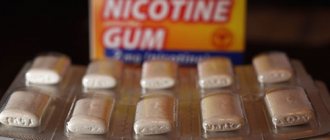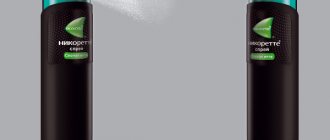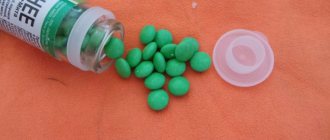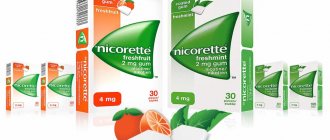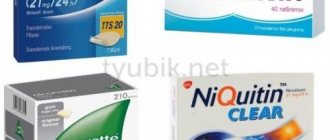Nicorette, 4 mg, chewing gum [frost mint], 30 pcs.
The dose is selected individually, depending on the intensity of smoking. As a general rule, Nicorette® 2 mg (moderate nicotine content) should be used if a person smokes less than 20 cigarettes per day or smokes the first cigarette within 30 minutes of waking up; Nicorette® 4 mg chewing gum (high nicotine content) should be used if a person smokes more than 20 cigarettes per day or failed to quit smoking while using 2 mg chewing gum.
How to use Nicorette® Chewing Gum
Nicorette® should be used in all cases where an irresistible urge to smoke occurs, in accordance with the following scheme:
1. Chew the gum slowly until a strong taste appears.
2. Stop chewing and leave the gum between the inside of your cheek and gum.
3. When the taste disappears, start chewing gum again.
Complete smoking cessation
You should chew only one pad at a time when you stop smoking.
When completely quitting smoking, the number of chewing gums per day is determined by the degree of dependence on nicotine, but is usually 8–12 pieces. per day and should not exceed 15 pcs. in a day. Chewing gum should be used at the indicated dose for up to 3 months, after which the daily number of chewing gums should be gradually reduced until completely discontinued. The drug is stopped when the daily dose is 1–2 pcs. in a day.
Regular use of chewing gum for more than 12 months is usually not recommended, but some people require longer therapy to avoid relapse into smoking.
Reducing the number of cigarettes smoked
Chewing gum should be used between smoking episodes to extend the intervals between smoking cigarettes in order to reduce cigarette consumption as much as possible. If within 6 weeks it is not possible to reduce your daily cigarette consumption, you should seek help from a specialist.
An attempt to quit smoking should be made as soon as a person feels that he is ready for this, but no later than 6 months after the start of therapy. If the patient has not been able to make a serious attempt to quit smoking within 9 months after starting therapy, a specialist should be consulted. Regular use of chewing gum for more than 12 months is generally not recommended. However, some former smokers may require longer-term treatment with chewing gum to prevent a return to smoking or previous levels of tobacco use. The simultaneous provision of medical counseling and psychological support usually increases the effectiveness of therapy.
Temporary cessation of smoking
Chewing gum can be used during times when you need to avoid smoking, such as when you are in a smoke-free area or in other situations when you need to avoid smoking.
Use in combination with Nicorette® transdermal nicotine therapeutic system (patch)
Smokers who have been unable to quit smoking using chewing gum alone, or who want to reduce their daily chewing gum intake due to local side effects, can use the Nicorette® patch along with 2 mg chewing gum.
Treatment should begin with one 15 mg/16 hour patch, which is placed on an intact area of skin every day upon waking in the morning and removed before bed, in combination with 2 mg chewing gum. Use at least 4 chewing gums of 2 mg per day; Usually 5-6 chewing gums are enough. Do not use more than 15 chewing gums per day. The full dose should be used for 6–12 weeks, after which the drug should be gradually weaned off.
Withdrawal from a combination of drugs
This can be done in two ways.
Method 1:
using a patch of lower dosage, i.e. application of the 10 mg/16 hour patch for 3–6 weeks followed by 3–6 weeks of application of the 5 mg/16 hour patch with the same number of 2 mg chewing gums as in initial therapy, and then gradually reducing the number of chewing gums 2 mg for 12 months.
Method 2
consists of stopping the use of the patch and gradually reducing the number of chewing gums of 2 mg for 12 months.
The recommended dosage is presented in the table.
Table
| Initial therapy | ||
| Period of time | Patch | Inhaler 10 mg |
| First 6–12 weeks | 1 patch 15 mg/16 h | Of necessity |
| (stage 1) daily | 5–6 chewing gums per day are recommended | |
| Withdrawal - method 1 | ||
| Next 3–6 weeks | 1 patch, 10 mg/16 h (stage 2) daily | Continue to use cartridges as needed |
| Next 3–6 weeks | 1 patch 5 mg/16 h | Continue to use cartridges as needed |
| Up to 12 months | — | Gradual weaning from chewing gum |
| Withdrawal - method 2 | ||
| Up to 12 months | Gradual weaning from chewing gum | |
Under the age of 18, chewing gum can only be used on the recommendation of a doctor. Do not exceed the indicated dose. Carry chewing gum with you so you can use it if you suddenly want to smoke.
Nicorette 4 mg n30 chewable. Res. frosty mint
Release form
Chewing gum is intended for the treatment of nicotine addiction. Available in the form of a square pad covered with a white or almost white shell. The pack contains 2 blisters with 15 chewing gums.
Package
30 pcs
pharmachologic effect
Nicorette Frosted Mint chewing gum is a drug for the treatment of nicotine addiction. After abrupt cessation of smoking, patients who use nicotine-containing products daily for a long time may develop a withdrawal syndrome, which includes dysphoria, insomnia, increased irritability, anxiety, impaired concentration, decreased heart rate, increased appetite and weight gain, and also the desire to smoke.
In the treatment of nicotine addiction, nicotine replacement therapy can reduce the need for smoking (and the number of cigarettes smoked), and reduce the severity of withdrawal symptoms that occur with complete cessation of smoking in those who decide to quit smoking. Facilitates temporary abstinence from smoking and helps reduce the number of cigarettes smoked in those who cannot or do not want to completely quit smoking.
Indications
For the treatment of tobacco addiction:
- reduction of withdrawal symptoms that occur with complete cessation of smoking in patients who decide to quit smoking;
- with temporary cessation of smoking;
- to reduce the number of cigarettes smoked by those who cannot or do not want to completely quit smoking.
Contraindications
Hypersensitivity to nicotine and other components of the drug.
Use during pregnancy and breastfeeding
Nicotine crosses the placental barrier and can have a negative effect on the respiratory system and blood circulation of the fetus. Smoking can cause serious harm to the fetus, so patients should be encouraged to stop smoking without using nicotine replacement therapy. If such attempts are unsuccessful, the decision to carry out therapy is made after comparing the possible positive effect and potential harm.
Nicotine (even when used in therapeutic doses) passes into breast milk in small quantities and may have an adverse effect on a nursing infant when taken by a nursing mother. In order to reduce the negative effects of nicotine on a child, Nicorette should be used immediately after feeding.
special instructions
The use of Nicorette® is associated with less risk than smoking.
The patient should be informed that he should carry Nicorette® chewing gum with him to use if he suddenly wants to smoke.
Patients with diabetes may need to reduce their insulin doses after stopping smoking.
For patients with impaired chewing function, it is recommended to use other dosage forms.
Use in pediatrics
There is no experience with the use of Nicorette® in adolescents under 18 years of age, so the drug should be used strictly as prescribed by a doctor.
Impact on the ability to drive vehicles and operate machinery
No negative effect on the ability to drive a car or operate machinery has been established.
Compound
Nicotine 4 mg
Excipients: chewing gum base, sorbitol powder, sorbitol solution (crystallizing), glycerol solution 85%, sodium carbonate, fragrance 84.6422, Haverstroo fragrance ZD49284, FDA certified quinoline yellow dye D&C No. 10.
Directions for use and doses
Depending on the severity of smoking addiction, Nicorette chewing gum with different concentrations of the active substance is used. If the patient smokes 20 or fewer cigarettes per day or smokes the first cigarette 30 minutes after waking up, then chewing gum with a nicotine content of 2 mg should be used. If the patient smokes more than 20 cigarettes per day or has failed to quit smoking while using chewing gum containing 2 mg nicotine, it is recommended to use chewing gum containing 4 mg nicotine.
Nicorette should be used in all cases when an irresistible urge to smoke arises. The gum should be chewed slowly until a strong taste appears, then the chewing should be stopped and the gum should be placed between the gum and the inside of the cheek. After the taste disappears, chewing should be resumed. Only 1 chewing gum should be used at a time.
If you completely quit smoking, the average daily dose is 8-12 gum, the maximum is 15 gum. It is necessary to continuously use the drug in the first 3 months after quitting smoking. Then you should gradually reduce the amount of gum consumed. When the daily consumption of the drug decreases to 1-2 gum, its use should be discontinued. However, you should always have a certain amount of the drug in stock, since the desire to smoke may suddenly arise again.
When reducing the number of cigarettes smoked, chewing gum should be used between smoking episodes to extend the intervals between smoking cigarettes to minimize cigarette consumption. The patient should be warned that if after 6 weeks of using the drug it has not been possible to reduce daily cigarette consumption, he should consult a specialist.
The patient should try to quit smoking when he is ready, but no later than 6 months after starting treatment. If you have not been able to quit smoking within 9 months after starting therapy, you should consult a specialist.
It is not recommended to use Nicorette chewing gum for more than 12 months. However, some patients may require longer treatment to prevent relapse or return to previous levels of tobacco use.
Chewing gum can be used during periods when you need to temporarily quit smoking, such as when you are in a smoke-free area or in other situations when you need to abstain from smoking.
Side effects
At the recommended dose, Nicorette® does not cause serious adverse effects. At the beginning of treatment, the nicotine contained in chewing gum can sometimes cause mild throat irritation and increased salivation; if an excessive amount of dissolved nicotine is swallowed, hiccups are possible.
If the drug is used excessively by persons who are not accustomed to inhaling tobacco smoke, nausea, weakness, and headache are possible (similar to the symptoms that occur in such patients when inhaling tobacco smoke).
From the side of the central nervous system:
very often - headache; often - dizziness.
From the cardiovascular system:
sometimes – rapid heartbeat; very rarely - atrial rhythm disturbances.
From the digestive system:
very often – gastrointestinal discomfort, hiccups, nausea; often - vomiting.
Dermatological reactions:
sometimes – erythema, urticaria.
Other:
very often – pain in the throat or mouth, pain in the masticatory muscles; rarely - allergic reactions, including angioedema.
Some symptoms, such as dizziness, headache, sleep disturbances, may be manifestations of withdrawal symptoms caused by quitting smoking. Quitting smoking may increase the incidence of aphthous stomatitis.
When using chewing gum containing 4 mg nicotine in patients predisposed to indigestion, minor indigestion or heartburn may occur. This problem usually resolves by chewing gum more slowly or by using gum containing 2 mg nicotine (at shorter intervals if necessary).
Drug interactions
Smoking (but not nicotine use) causes an increase in CYP1A2 activity. After smoking cessation, there may be a decrease in the clearance of substrates of this enzyme, which can lead to an increase in the concentration of certain drugs in the blood plasma, which has potential clinical significance when used simultaneously with drugs characterized by a low breadth of therapeutic action (theophylline, tacrine, clozapine, ropinirole).
Limited data suggest that smoking may induce the metabolism of flecainide and pentazocine.
Overdose
Symptoms:
nausea, drooling, abdominal pain, diarrhea, sweating, headache, dizziness, hearing loss and severe general weakness; in severe cases - arterial hypotension, weak and irregular pulse, difficulty breathing, vascular collapse and generalized convulsions, i.e. symptoms of acute nicotine poisoning.
Doses of nicotine that are well tolerated during treatment in adult smokers can cause symptoms of severe poisoning in young children and can even be fatal.
Treatment:
You should immediately stop taking nicotine and begin symptomatic treatment. Activated carbon reduces the absorption of nicotine in the gastrointestinal tract. If necessary, mechanical ventilation and oxygen are prescribed.
Storage conditions
The drug should be stored out of the reach of children at a temperature not exceeding 25°C.
Best before date
2.5 years
Nicotine gum/patches for quitting smoking
September 27, 2016
Smoking poisons not only the person, but also everyone around. It's nice that more and more people are giving up this bad habit. However, this is not as easy to do as it seems at first. For painless withdrawal, humanity has come up with nicotine patches and chewing gum, but how do they work? We'll tell you in this article.
Now it’s very nice to see that a healthy lifestyle is not some phenomenon that is extremely rare, but quite an excellent trend and one might even say fashion. Therefore, it is gratifying that the majority of people who previously smoked begin to give up this harmful habit on their own. There is, however, nothing mysterious about the smoke - it just brings health problems. However, nicotine is not so simple: it is already clear to everyone that it develops not only a psychological habit in a person, but also affects the body on a physical level, forcing one to smoke cigarettes again and again. Thanks to modern science, a person is offered a variety of means to choose from, which in various ways and methods help to give up smoking, which poisons the body every day. In addition to the usual abrupt withdrawal once and for all, there are less severe and therefore very popular methods - nicotine chewing gum or patches. However, everyone who is planning to quit smoking asks the question: “How do they work and what is better to choose?” In this article we will look at these ways to get rid of cigarette addiction. To understand how to get rid of an addiction, you need to know how it appears in the body. Like any other drug, nicotine has psychoactive properties, which allows it to mask its negative effects. The first puffs bring a feeling of cheerfulness, improved mood, and therefore the person continues to smoke in order to feel these sensations again. However, it is at this moment that the first degree of dependence is formed in his body - psychological, and, continuing to poison himself, a second, more serious problem occurs - physical dependence. Therefore, some time after the first puff, a person can no longer give up a cigarette due to withdrawal syndrome (with a long absence of nicotine, nausea, increased irritability, sleep disturbance and a feeling of weakness begin) It is on this knowledge that the simple principle of action of a nicotine patch or chewing gum is based . They contain a certain dose of nicotine, which, penetrating through the pores on the skin or saliva into the blood, relieves this very “withdrawal”. However, let's look at everything in more detail. Nicotine patch.
According to reviews, it is the most preferable way to get rid of addiction, but here it is worth considering the fact that the patch, like any remedy, is effective only if you follow all the instructions for use and use it regularly.
Most of the patches available in pharmacies must be used daily and each time you apply it, apply it to other areas of the body. Typically, the time for which it sticks is about 12-15 hours, and during this period an amount of nicotine equal to one pack of cigarettes enters the human blood. That is why there are cases when, after smoking, a person becomes ill - this is a consequence of an overdose. It would seem that nicotine also enters the body, but the one contained in the patch is slightly different - it is not bound to blood plasma proteins, therefore it does not have such a strong effect on the body. In addition, when smoking, additional elements of the cigarette cause harm. On average, it takes about 7-9 weeks to get rid of addiction. Nicotine gum.
They work in much the same way as the patch, but instead of being applied to the skin, the nicotine enters the bloodstream through the stomach and liver. They differ in nicotine content, and to begin with, we recommend using those that have the highest content and in the future, if you experience discomfort, switch to a lower nicotine value. There are also some peculiarities in use - you do not need to chew such gum as regular gum, since in this case the nicotine will quickly be released and thereby the effect of the action will be reduced. To increase the duration, it is recommended to alternate between short-term chewing and simply sucking it. You need to “chew” about 10 records in this way per day, and to get rid of addiction it is recommended to use nicotine gum for 2 months. Whatever method you choose to quit smoking, remember that you will achieve a truly effective effect only if you wish and follow the instructions for use. Also, before using nicotine gum or applying a patch, we recommend that you consult a doctor for advice on contraindications.
Tags:
- Smoking
- Addiction
- Nicotine
To leave a comment you must be an authorized user
